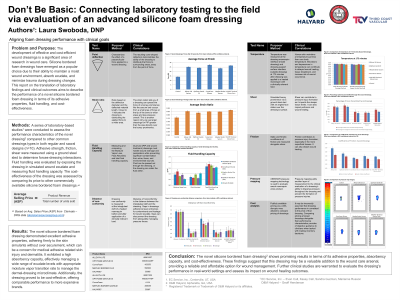Laboratory Research
(LR-046) Aligning Foam Dressing Performance with Clinical Goals
Friday, May 2, 2025
7:45 PM - 8:45 PM East Coast USA Time

Introduction:
Background:
Foam dressings have become a mainstay in modern wound care, offering numerous benefits such as exudate management and a moist wound healing environment. However, not all foam dressings are created equal. Variations in performance characteristics can impact prophylactic outcomes, wound healing & patient comfort.
Objectives:
Methods: Materials and
Methods:
Results:
Results:
Discussion:
Discussion: The findings of this study highlight the importance of considering foam dressing performance characteristics when selecting appropriate products for wound prophylaxis & care. Optimal MVTR and temperature control are essential for maintaining both intact skin and a conducive wound healing environment. Additionally, strong and reliable adhesion is crucial for preventing dressing dislodgement and minimizing skin trauma, but must be tampered with the risk of MARSI. By aligning foam dressing performance with specific clinical goals, healthcare providers can optimize wound care and improve patient outcomes.
Conclusion: Laboratory testing of foam dressing performance characteristics, combined with clinical evidence, can inform evidence-based decision-making in wound care. By understanding the impact of factors such as MVTR, temperature, and adhesion on skin, clinicians can select the most appropriate dressings to achieve optimal outcomes and enhance patient care.
Background:
Foam dressings have become a mainstay in modern wound care, offering numerous benefits such as exudate management and a moist wound healing environment. However, not all foam dressings are created equal. Variations in performance characteristics can impact prophylactic outcomes, wound healing & patient comfort.
Objectives:
- To evaluate the microclimate properties of various foam dressings, including moisture vapor transmission rate (MVTR) and temperature.
- To assess the adhesion properties of foam dressings to different skin types and wound bed conditions.
- To correlate these laboratory findings with clinical outcomes and patient preferences.
Methods: Materials and
Methods:
- Foam Dressings: A diverse range of foam dressings with varying composition, thicknesses, absorbency, and adhesive properties were selected.
- Microclimate Testing: MVTR and temperature were measured using a validated laboratory setup.
- Adhesion Testing: Peel tests were conducted on standardized skin simulants to assess adhesive strength and detachment mode.
- Clinical Correlation: A review of clinical findings was performed to identify patient outcomes associated with different foam dressings.
Results:
Results:
- Variations in MVTR and temperature were observed among the different foam dressings.
- Adhesion strength and detachment mode are influenced by factors such as dressing thickness, adhesive type, and skin condition.
- Clinical outcomes were correlated with dressing performance characteristics including: MARSI, dermatitis, undisturbed wound healing, economic findings, and wound prophylaxis
Discussion:
Discussion: The findings of this study highlight the importance of considering foam dressing performance characteristics when selecting appropriate products for wound prophylaxis & care. Optimal MVTR and temperature control are essential for maintaining both intact skin and a conducive wound healing environment. Additionally, strong and reliable adhesion is crucial for preventing dressing dislodgement and minimizing skin trauma, but must be tampered with the risk of MARSI. By aligning foam dressing performance with specific clinical goals, healthcare providers can optimize wound care and improve patient outcomes.
Conclusion: Laboratory testing of foam dressing performance characteristics, combined with clinical evidence, can inform evidence-based decision-making in wound care. By understanding the impact of factors such as MVTR, temperature, and adhesion on skin, clinicians can select the most appropriate dressings to achieve optimal outcomes and enhance patient care.

.jpg)